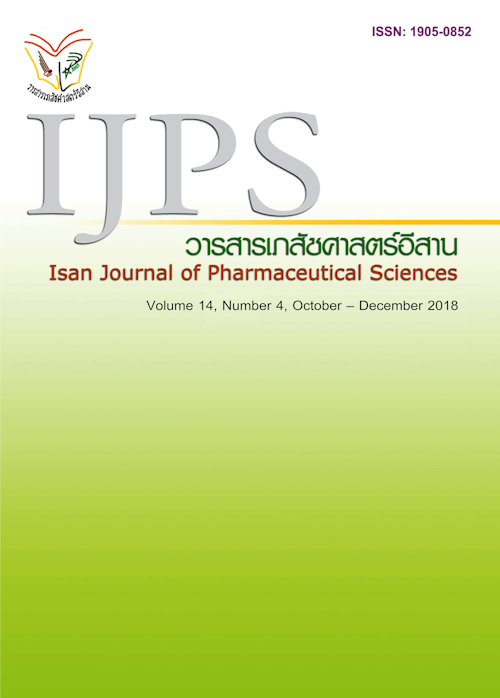Satisfaction of the Rehabilitation Stroke Patients on the Services of Homeopathy as an Alternative Medicine at Sunpasitthiprasong Hospital, Ubon Ratchathani
Main Article Content
Abstract
Stroke patients always have a physical disability. Homeopathy is one of the alternative medicine that patients can choose to rehabilitate their physical and mental symptoms together with allopathy. Researchers are interested in the characteristic and satisfaction of stroke patients on the services of homeopathy as an alternative medicine at Sunpasitthiprasong Hospital, Ubon Ratchathani. Methods: This study used a mixed methods approach through a quantitative analysis of a satisfaction survey and a qualitative analysis of in-depth interviews with stakeholders. The researchers collected data from the stroke patients who were admitted to the homeopathic clinic in Sunpasitthiprasong Hospital at least one time by purposive sampling. The data were analyzed by descriptive statistics and content analysis. Results: Eighteen patients who attended the homeopathic clinic were mostly male (61.11%) between the ages of 60-69 years (33.33%), 40-49 years (33.33%) and had hypertension (88.89%). The most frequently prescribed homeopathic remedy was Stramonium (27.78%) and most patients were treated by homeopathy after diagnosis of stroke for less than 6 months (44.44%). Regarding satisfaction, most patients rated being satisfied or very satisfied with the service at the homeopathic clinic. The mean (±SD) of overall patient satisfaction score was 4.43 (±0.20). Eleven patients and their relatives were in-depth interviewed. From the interview, all patients knew the homeopathy from the advice of the physician working at Thai and traditional medicine clinic at Sunpasitthiprasong Hospital. The main reason that patients decided to attend the homeopathic clinic was taking the opportunity to try a new alternative treatment. Some patients (20.00%) have not clearly understood the principle and protocol of homeopathic treatment. As the results of homeopathic treatment, all patients were mentally improved with the better mood, not discourage and less depress. The patients showed eye contact and more interested in the environment surrounded. The information was from patients and their caregivers. Some patients were both mentally and physically improved e.g., more ability to move and take care of themselves, more tolerate against the physical forces, more effective in communication and answering the questions. Conclusion: Most patients had hypertension and were treated by homeopathy after diagnosis of stroke for less than or equal to 6 months. The most frequently prescribed homeopathic remedy was Stramonium. Regarding satisfaction, most patients rated being satisfied or very satisfied with the service at the homeopathic clinic. Most patients rated being satisfied or very satisfied in all domains with the service at the homeopathic clinic.
Article Details
In the case that some parts are used by others The author must Confirm that obtaining permission to use some of the original authors. And must attach evidence That the permission has been included
References
Barnes PM, Griner EP, Fann KM, Nahin RL. Complementary and Alternative Medicine Use Among Adults: United States, 2002. Advance data from vital and health statistics 2004;343:1-20.
Bureau of Non Communicable Diseases. Annual report 2016. Bangkok: Aksorn Graphic and Design Publishing House (Head Office); 2017.
Chirunthorn R, Singpaiboonporn N, Kamkwaew J, Phudpad B, Uuisui P. Assessment of patients' satisfaction with Thai traditional medicine services: a case study of the Department of Thai Traditional Medicine, Community Health Center of Songkhla Hospital, Songkhla province. Songkla Med J 2006;24(6):517-526
Close S. The Genius of homeopathy: Lectures and essays on homeopathic philosophy. B.Jain publishers (P) Ltd, New Delhi, India. 2005.
Dedkhard S. Effects of Rehabilitation Program Using Complementary Therapy in Stroke Patients. J Prapokklao Hosp Clin Med Educat Center 2015;32(2):135-46.
Jaruwanchai P, Jarinto K. Characteristic of patients using alternative medicine in public hospitals. Journal of Graduate Studies Valaya Alongkorn Rajabhat University 2016;9(2): 73-84.
Mathie RT. The research evidence base for homeopathy: a fresh assessment of the literature. Homeopathy 2003;92(2):84-91.
Namsaeng C, Topark-Ngarm. Assessment of Patients' Satisfaction in Thai Traditional Medicine Services at Government Hospitals, Udon Thani Province. KKU Res J (GS) 2016;16(1):77-89.
National Center for Complementary and Integrative Health. The use of complementary and alternative medicine in the United States. [Internet]. 2017 [cited 2018 June 28]. Available from: https://nccih.nih.gov/research/statistics/2007/camsurvey_fs1.htm
National Stroke Association. Post-Stroke Conditions. [Internet]. 2014 [cited 2017 Dec 8]. Available from: http://www.stroke.org/we-can-help/survivors/stroke-recovery/post-stroke-condition
Nilanon Y. Taking care after paralysis. [Internet]. Bangkok: Faculty of Medicine Siriraj Hospital; 2010 [cited 2017 Oct 20]. Available from:http://www.si.mahidol.ac.th/sidoctor/e-pl/articledetail.asp?id=707.
Panjinda W, Chucherd P. Achieving a Holistic Approach in Stroke Rehabilitation. Association of private higher education institutions of Thailand 2016;5(2):70-8.
Sherer P, Wongoubpharat P. A study of the use of alternative medicine in Thai people. Report of Thai traditional Medical. Folk medicine and alternative medicine in 2007-2009. Bangkok: Samcharoenpanich; 2010.
Sowanna N. Homeopathy: Science of alternative medicine and application. J Med Health Sci 2017;24(2): 72-82.
Taechakijkosol R. Stress and coping in the rehabilitation stroke patient at Siriraj Hospital. World Health Organization. Stroke, Cerebrovascular accident. [Internet]. 2014 [cited 2017 Dec 8]. Available from:http://www.who.int/topics/cerebrovascular_accident/en/
Yutyingyong W. Alternative medicine in stroke patients case study: Wat Thung Bor Pan Lampang [Dissertation]. Nakhonpathom: College of religious studies; 2008.


